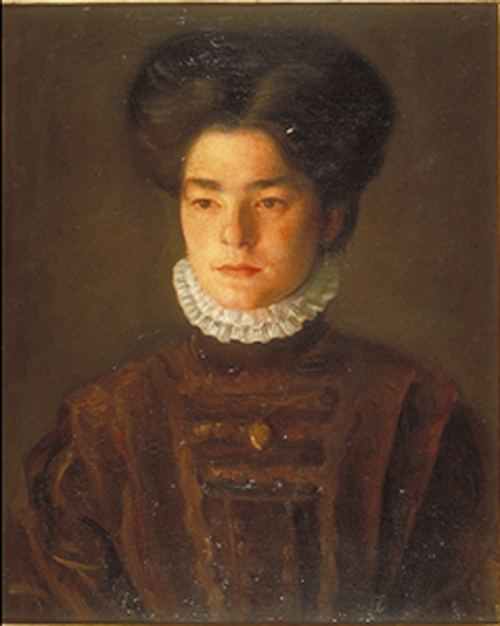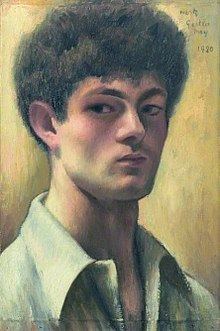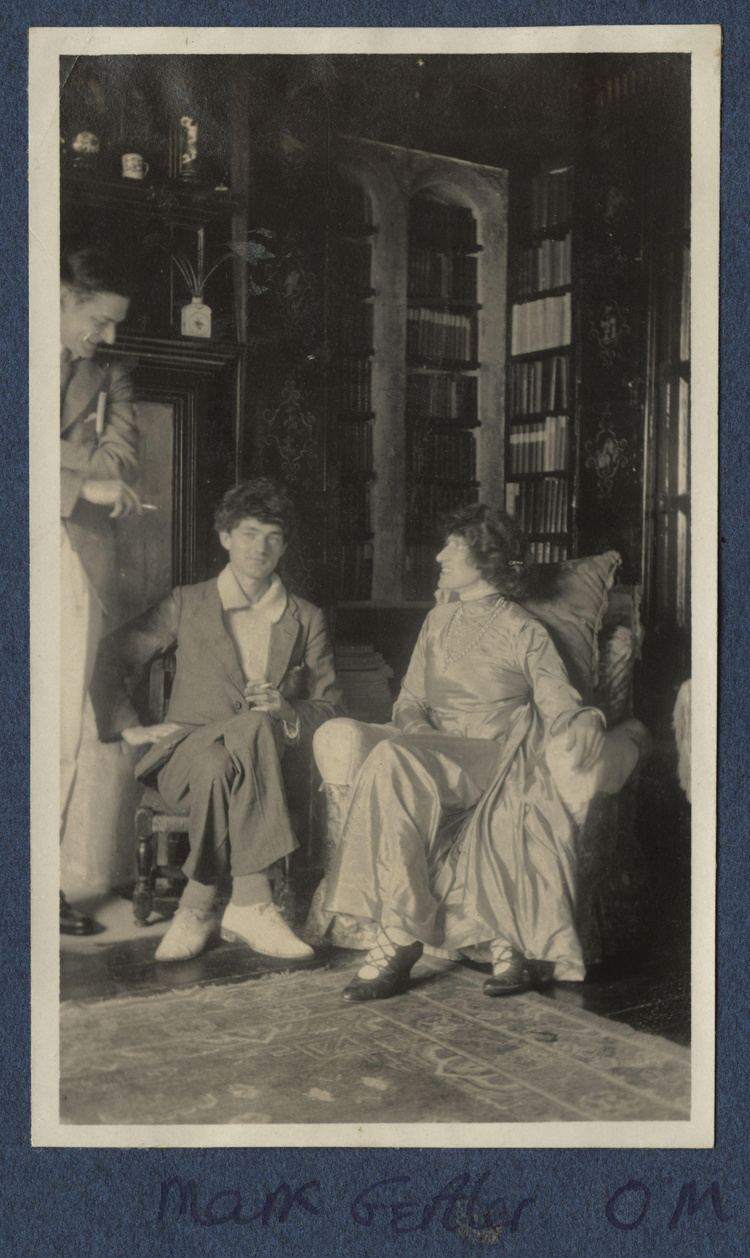Name Mark Gertler | Role Artist | |
 | ||
Died June 23, 1939, London, United Kingdom Education University of Westminster, Slade School of Fine Art Similar People Gilbert Cannan, Jordi Gali, Mary Ansell, Jeremy Bentham | ||
Miles aldridge inspired by mark gertler
Mark Gertler (9 December 1891 – 23 June 1939), born Marks Gertler, was a British painter of figure subjects, portraits and still-life.
Contents
- Miles aldridge inspired by mark gertler
- Hommage mark gertler by f fiorellino
- Early life
- Career
- Legacy
- References

His early life and his relationship with Dora Carrington were the inspiration for Gilbert Cannan's novel Mendel. The characters of Loerke in D. H. Lawrence's Women in Love and Gombauld in Aldous Huxley's Crome Yellow were based on him.

Hommage mark gertler by f fiorellino
Early life

Marks Gertler was born on 9 December 1891 in Spitalfields, London, the youngest child of Polish Jewish immigrants, Louis Gertler and Kate "Golda" Berenbaum. He had four older siblings: Deborah (b. 1881), Harry (b. 1882), Sophie (b. 1883) and Jacob "Jack" (b. 1886).

In 1892 his parents took the family to his mother's native city, Przemyśl, Austria-Hungary (now Poland), where they worked as innkeepers. Though Louis was popular with his customers, mainly Austrian soldiers, the inn was a failure. One night without telling anyone Louis simply left for America (ca. 1893) in search of work. He eventually sent word to Golda telling her that once he was settled she was to bring the children to live with him there. However, this venture also failed and his family never joined him in America.

Instead Louis returned to Britain, and had his family join him in London in 1896, when Marks' forename was anglicised as "Mark".
From an early age Gertler showed signs of a great talent for drawing. On leaving school in 1906, he enrolled in art classes at Regent Street Polytechnic. Unfortunately, due to his family's poverty, he was forced to drop out after a year, and in December 1907 began working as an apprentice at Clayton & Bell, a stained glass company. He disliked his work there and rarely spoke of it in later years. While there he attended evening classes at the Polytechnic. In 1908 Gertler was placed third in a national art competition; this inspired him to apply for a scholarship from the Jewish Education Aid Society (JEAS) to resume his studies as an artist. The application was successful. Upon the advice of the prominent Jewish artist William Rothenstein, in 1908 he enrolled at the Slade School of Art, University College, London. During the four years he spent at the Slade, Gertler was a contemporary of Paul Nash, Edward Wadsworth, C.R.W. Nevinson, Stanley Spencer and Isaac Rosenberg, among others.
During his time at the Slade Gertler met the painter Dora Carrington, whom he pursued relentlessly for many years. His obsessive love for Carrington is detailed in his published letters (see bibliography below) and in Sarah MacDougall's book Mark Gertler. It is also represented in the feature film Carrington (1995). His love for Carrington was unrequited, and she spent most of her life living with the homosexual author Lytton Strachey, with whom she was deeply in love. Carrington's unconventional relationship with Strachey, of whom Gertler was extremely jealous, and her eventual marriage to Ralph Partridge, destroyed her equally complex relationship with Gertler. He had been so distraught when he learned of Carrington's marriage that he tried to purchase a revolver, and threatened to commit suicide.
Career
Gertler's patron was Lady Ottoline Morrell, through whom he became acquainted with the Bloomsbury Group. She introduced him to Walter Sickert, the nominal leader of the Camden Town Group. Gertler was soon enjoying success as a painter of society portraits, but his temperamental manner and devotion to advancing his work according to his own vision led to increasing personal frustration and the alienation of potential sitters and buyers. As a result, he struggled frequently with poverty.
In 1914 the polymath art collector Edward Marsh became Gertler's patron. The relationship between the two men proved a difficult one, as Gertler felt that the system of patronage and the circle in which he moved were in direct conflict with his sense of self. In 1916, as World War I dragged on, Gertler ended the relationship due to his pacifism and conscientious objection (Marsh was secretary to Winston Churchill and patron to some of the war poets). Gertler's major painting, Merry-Go-Round, was created in the midst of the war years and was described by Lawrence as "the best modern picture I have seen" (Letters, 9 October 1916).
In 1913 Gertler met the author and poet Gilbert Cannan, who later described him as 'a small passionate man with green eyes'. Cannan subsequently invited Mark to stay with him and his wife Mary at their Mill House in Cholesbury and the two men became good friends. Gertler lived there on and off during 1915–16, and painted Gilbert Cannan at his Mill, now on view in the Ashmolean Museum in Oxford. The picture depicts Cannan outside the Mill with his two dogs. The black and white one, Luath, had been the inspiration for the dog Nana in the stage production of J. M. Barrie's Peter Pan. It was Cannan who was responsible for introducing Lady Ottoline Morrell to Gertler's paintings and encouraging her to support his work. Cannan closely based the young Jewish character of his 1916 novel Mendel on Gertler's early life including his infatuation and affair with fellow artist Dora Carrington. This relationship remained unfulfilled as Carrington spurned his numerous advances and instead declared her love for Lytton Strachey. The friendship of Cannan and Gertler waned after 1916, largely because of Cannan's increasingly unstable behaviour.
Virginia Woolf recorded her impressions of Gertler after he came to visit her and her husband in Sussex in September 1918. As he left they cried,
“Good God, what an egoist!” We have been talking about Gertler to Gertler for some 30 hours; it is like putting a microscope to your eye. One molehill is wonderfully clear; the surrounding world ceases to exist. But he is a forcible young man; if limited, able & respectable within those limits; as hard as a cricket ball; & as tightly rounded & stuffed in at the edges. We discussed — well, it always came back to Gertler. “I have a very peculiar character ... I am not like any other artist ... My picture would not have those blank spaces ... I don’t see that, because in my case I have a sense which other people don’t have ... I saw in a moment what she had never dreamt of seeing ...” & so on. And if you do slip a little away, he watches very jealously, from his own point of view, & somehow tricks you back again. He hoards an insatiable vanity. I suspect the truth to be that he is very anxious for the good opinion of people like ourselves, & would immensely like to be thought well of by Duncan [Grant], Vanessa [Bell] & Roger [Fry]. His triumphs have been too cheap so far. However this is honestly outspoken, & as I say, he has power & intelligence, & will, one sees, paint good interesting pictures, though some rupture of the brain would have to take place before he could be a painter.
Gertler's later works developed a sometimes very harsh edge to them, influenced by his increasing ill health. In 1920 he was diagnosed with tuberculosis, which forced him to enter a sanatorium on a number of occasions during the twenties and thirties. Two of Gertler's close friends, D. H. Lawrence and Katherine Mansfield, succumbed to the disease.
In 1930 Gertler married Marjorie Greatorex Hodgkinson, which resulted in the birth of a son, Luke Gertler, in 1932. The marriage was often difficult, punctuated by the frequent ill health of both, and with Gertler often suffering from the same feelings of constraint that destroyed his relationships with a number of friends and patrons.
During the 1930s he became a part-time teacher at the Westminster School of Art in order to supplement his intermittent income from painting.
Gertler gassed himself in his London studio in 1939, having attempted suicide on at least one occasion in 1936. He was suffering at the time from increasing financial difficulties, his wife had recently left him, he had held a critically derided exhibition at the Lefevre Gallery, he was still depressed over the death of his mother and Carrington's own suicide (both in 1932), and he was filled with fear over the imminent world war. He was buried at Willesden Jewish Cemetery.
Legacy
Gertler’s obituary in The Times described his death as ‘a serious loss to British art. Opinions of his work are likely to vary,’ it conceded, ‘but it is safe to say that a considered list of the half-dozen most important painters under fifty working in England would include him'. Gertler's paintings are held in numerous public art collections, including in the Glasgow Museums. In June 2015 his 1912 painting The Violinist was auctioned for £542,500 at Christie's, London a record for the sale of his work.
Today Gertler's Spitalfields residence is home to the atelier of British tailor Timothy Everest.
